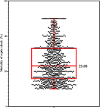Carbapenem is not always the best choice in the treatment of septic shock
- PMID: 37749658
- PMCID: PMC10518951
- DOI: 10.1186/s40001-023-01341-x
Carbapenem is not always the best choice in the treatment of septic shock
Abstract
Background: Septic shock is a global public health burden. In addition to the improvement of the level of individual care, the improvement of the overall hospital quality control management is also an essential key aspect of the Surviving Sepsis Campaign (SSC). Using of antibiotics is a cornerstone in the treatment of septic shock, so we conducted this study to investigate the influence of antibiotics and pathogenic bacteria on the mortality of septic shock at the level of overall hospital in China.
Methods: This was an observational database study in 2021 enrolled the data of 787 hospitals from 31 provinces/municipalities/autonomous regions of Mainland China collected in a survey from January 1, 2021 to December 31, 2021.
Results: The proportion of ICU patients with septic shock was 3.55%, while the patient mortality of septic shock was 23.08%. While carbapenem was the most preferred antibiotic medication used in 459 of the 782 hospitals, the preference for carbapenem did not show significant effect on the patient mortality in the treatment of septic shock (p-value 0.59). Compared with patients with fermenting bacteria as the most common pathogenic bacteria causing septic shock, patients with non-fermenting bacteria had a higher mortality (p-value 0.01).
Conclusions: Whether using carbapenem as the preferred antibiotic or not, did not show effect on the patient mortality of septic shock. Compared with patients with fermenting bacteria as the most common pathogenic bacteria, patients of septic shock with non-fermenting bacteria had a higher mortality.
Keywords: Carbapenem; Fermenting bacteria; Hospital management; Mortality; Septic shock.
© 2023. BioMed Central Ltd., part of Springer Nature.
Conflict of interest statement
The authors declare that they have no competing interests.
Figures



Similar articles
-
Empiric antibiotic treatment reduces mortality in severe sepsis and septic shock from the first hour: results from a guideline-based performance improvement program.Crit Care Med. 2014 Aug;42(8):1749-55. doi: 10.1097/CCM.0000000000000330. Crit Care Med. 2014. PMID: 24717459
-
Association between quality control and outcomes of septic shock caused by intestinal perforation in China: a cross-sectional study.Sci Rep. 2023 Feb 27;13(1):3373. doi: 10.1038/s41598-023-30551-w. Sci Rep. 2023. PMID: 36849534 Free PMC article.
-
Carbapenem-resistant Gram-negative pathogens associated with septic shock: a review of 120 cases.J Chemother. 2022 Nov;34(7):436-445. doi: 10.1080/1120009X.2022.2064703. Epub 2022 Apr 21. J Chemother. 2022. PMID: 35446235 Review.
-
The DISPARITY-II study: delays to antibiotic administration in women with severe sepsis or septic shock.Acad Emerg Med. 2014 Dec;21(12):1499-502. doi: 10.1111/acem.12546. Epub 2014 Nov 25. Acad Emerg Med. 2014. PMID: 25424151
-
Does Early and Appropriate Antibiotic Administration Improve Mortality in Emergency Department Patients with Severe Sepsis or Septic Shock?J Emerg Med. 2017 Oct;53(4):588-595. doi: 10.1016/j.jemermed.2016.12.009. Epub 2017 Sep 12. J Emerg Med. 2017. PMID: 28916120 Review.
References
Publication types
MeSH terms
Substances
Grants and funding
LinkOut - more resources
Full Text Sources
Medical

